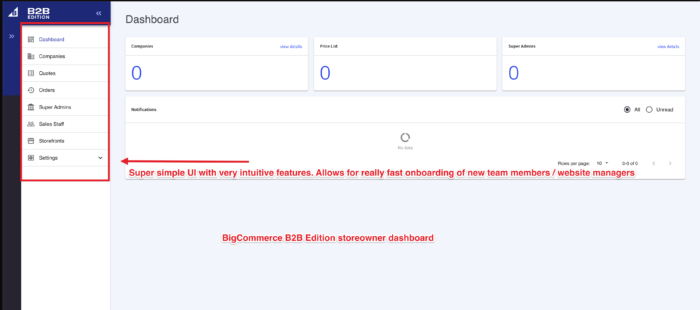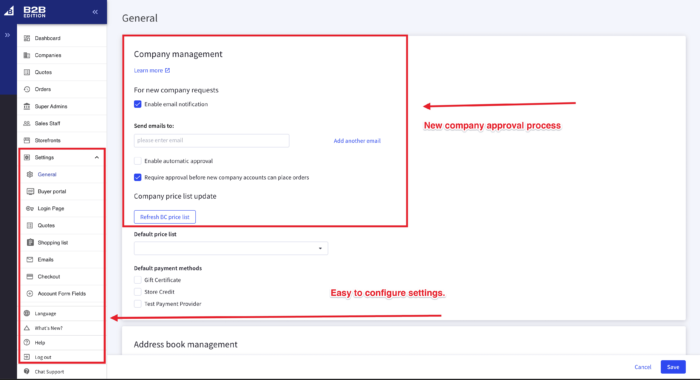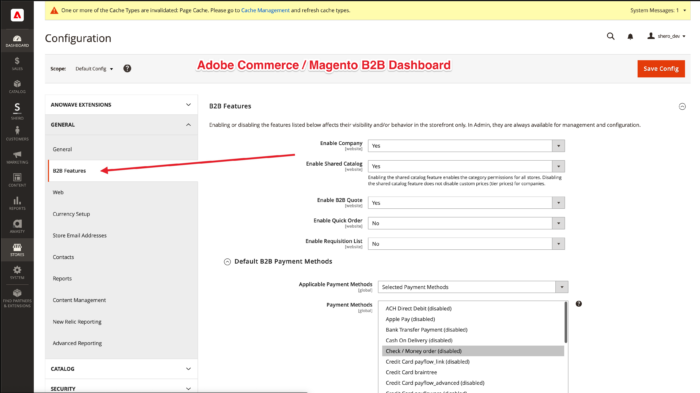Selecting the right platform for B2B eCommerce can be a game-changer for you and your company. BigCommerce vs. Adobe Commerce B2B (formerly known as Magento B2B) are two popular contenders in the B2B world. It’s important to understand their features, capabilities, and how they compare to make an informed decision between the two. This guide aims to provide a detailed comparison between BigCommerce B2B and Adobe Commerce (Magento B2B from hereon).
If you would like our help deciding which platform is right for you, contact us!
Table of contents
Understanding B2B eCommerce
What is a B2B eCommerce platform?
Unlike B2C (business-to-consumer) eCommerce, where a merchant sells directly to a consumer, B2B (business-to-business) eCommerce platforms are designed to meet businesses’ unique requirements that sell to other companies. They provide features like bulk ordering, custom pricing, and robust account management tools essential for B2B transactions. In summary, they help you streamline operations, enhance customer satisfaction, and drive sales to other companies, usually wholesale.
Key differences between B2B and B2C eCommerce
B2B and B2C eCommerce are two distinct online selling models that cater to different customer types. In B2B eCommerce, the primary focus is selling products or services to other companies for further use or resale. B2B transactions often involve larger order volumes, longer sales cycles, and more complex pricing structures. The relationships between the buyer and seller are typically based on negotiated contracts and personalized agreements.
B2C eCommerce, on the other hand, involves businesses selling directly to individual consumers. The focus is on delivering products or services for personal use. B2C transactions often involve smaller volumes, shorter sales cycles, and simpler pricing structures. The customer relationships in B2C eCommerce are usually more transactional and less personalized, with a greater emphasis on marketing and customer experience.
While both models involve online sales, the key differences lie in the target audience, transaction dynamics, average order value, and customer relationships.
Advantages of adopting B2B eCommerce for businesses
Adopting B2B eCommerce can offer several benefits for companies.
B2B eCommerce streamlines the purchasing process and improves efficiency. It allows businesses to sell 24/7 and automate order processing, inventory management, and payment systems by reducing manual errors and overhead. This increased efficiency can lead to cost savings and improved productivity.
You’ll have happier customers/vendors. B2B eCommerce enables businesses to enhance customer satisfaction. Online platforms provide convenient access to product information, pricing, personalized catalogs, discounts, and tailored services, improving the overall customer experience.
Lastly, B2B eCommerce facilitates better communication and collaboration with business partners. It allows for seamless integration of supply chains, real-time data sharing, and improved coordination between buyers and sellers.
These advantages make B2B eCommerce a valuable tool for businesses seeking growth, operational efficiency, customer satisfaction, and stronger partnerships.
Exploring BigCommerce for B2B
BigCommerce Overview
Established in 2009, BigCommerce is a leading B2B eCommerce platform. In the past few years, BigCommerce has made major investments into its platform’s B2B feature set by acquiring companies like BundleB2B and B2B Ninja. Such acquisitions allow BigCommerce to offer a user-friendly interface, powerful features, and scalable infrastructure explicitly tailored for B2B operations.
With BigCommerce, businesses can easily set up and manage their online storefront, showcase their products or services, and provide a seamless shopping experience to their B2B customers. Their range of B2B functionalities includes advanced product catalog management, personalized pricing and discounts, flexible payment options, and sophisticated inventory and order management tools.
Furthermore, BigCommerce integrates with popular business ERPs like Netsuite, Microsft Dynamics, Acumatica, Epicor, and many more, enabling businesses to streamline operations and enhance efficiency. Overall, BigCommerce is a reliable, affordable, and versatile B2B eCommerce platform, empowering businesses to optimize their online presence and drive growth in the competitive B2B marketplace.
BigCommerce’s B2B Features and Capabilities
After their acquisitions, BigCommerce combined the companies into a single, uniform solution called BigCommerce B2B Edition. Here is a breakdown of the key functionalities available to sellers and buyers:
BigCommerce B2B Seller Tools and Features:
- Account Dashboard: Offers a centralized hub for managing various aspects of the B2B business.
- Price Lists: Allows efficient management of personalized pricing for different customer segments or specific companies by overriding populated catalog prices.
- Customer Groups/Companies: Enables easy application, management, and approval of Company accounts, streamlining the process of managing B2B accounts.
- Super Admin Masquerade: Allows store owners to log in to assigned Company accounts as the client to provide personalized assistance and support.
- Sales Staff Quoting: Facilitates targeted pricing and customized quoting for specific B2B customers, improving the overall sales process.
- Multi-Storefront Features: Simplified quotes, orders, and invoice management across multiple storefronts.

BigCommerce B2B Buyer Features:
- Company Account Application: Enables B2C customers to submit a Trade Professional Application, thus quickly expanding the customer base.
- Company Account Application Status: Notifies customers about the approval or rejection of their B2B account application.
- Buyer Portal: Provides a user-friendly interface for Company admins to manage B2B actions efficiently.
- User Management: Allows Company admins to assign and edit user roles within their B2B account, ensuring streamlined access control.
- Shopping List Approval: Streamlines ordering by allowing Junior Buyers to curate and submit Shopping Lists for approval.
- Bulk Ordering Tools: Enables efficient ordering in bulk with features like Quick Order via SKU and CSV upload.
Managing Company Accounts in B2B Edition:
- Company Account Approval: Review and approve Company account applications to ensure access to B2B offerings is limited to legitimate customers.
- Company Account Management: Update account information, assign pricing tiers, and configure specific account settings.
- User Management: Create user accounts, assign roles and permissions, and control access to features or pricing tiers.

Order Management and Sales Representative Functions in BigCommerce B2B Edition:
- Streamlined Order Processing: Features like order approval workflows, automated order notifications, and order tracking allow for a simplified order process
- Sales Representative Access: Allow Sales Representatives to access assigned Company accounts, view tiered pricing, and place orders on behalf of the Company.
- Quoting and Negotiation: Generate and manage sales quotes, negotiate pricing, and communicate seamlessly with customers.
Pros and Cons of BigCommerce for B2B
Advantages:
BigCommerce offers several advantages for B2B businesses. The main ones are the user-friendly interface and pre-built templates, allowing for a quicker setup and launch of the B2B online store.
Next is the lower cost and time to market. BigCommerce’s subscription-based model includes hosting and dedicated support, reducing maintenance costs, and providing reliable technical support.
BigCommerce’s scalability and flexibility accommodate businesses at various stages of growth. Features like custom pricing, customer-specific catalogs, and B2B-specific checkout options enhance personalized experiences for B2B customers.
Disadvantages:
While BigCommerce has numerous advantages, it has some limitations for B2B businesses. One of the main drawbacks is customization limitations. Compared to open-source platforms like Magento, BigCommerce it less suitable for highly complex and unique B2B requirements.
Some advanced B2B features like quoting and negotiation may not be available out of the box and may require additional configurations or customization.
As a SAAS cloud-hosted solution, businesses may have less control over the hosting environment, data, and server-level customization.
Lastly, BigCommerce’s pricing plans are based on factors such as annual revenue and sales volume, which may result in higher costs for rapidly growing businesses. Businesses should consider these limitations alongside their specific B2B needs when evaluating BigCommerce as their preferred platform. Nonetheless, I still think BigCommerce is a strong contender for B2B.
Evaluating Magento for B2B
Magento Overview
Magento is a renowned eCommerce platform that has been around since 2007. In 2018 Magento was bought by Adobe. A few years later was rebranded to Adobe Commerce. Currently, there are two versions of Magento. There is the Magento Open Source, which has no B2B functionality out of the box. Usually, an extension is needed to do B2B with Magento Open Source. The functionality listed below comes out of the box with the paid version, Adobe Commerce / Magento. To properly sell to B2B buyers, you will need the Commerce version of Magento.
With its extensive features and capabilities, Magento is well-suited to meet the specific needs of B2B eCommerce. It provides businesses with advanced catalog management, enabling them to handle complex product catalogs efficiently.
Magento also offers custom pricing and negotiation options, allowing businesses to personalize pricing for different customer segments. Key features include customer-specific catalogs, account management tools, and quick order functionality.
The scalability and flexibility of Magento empower businesses to grow and adapt to changing market demands. With its robust feature set and flexibility, Magento is a powerful platform that can help companies optimize their B2B operations and deliver customers a seamless and personalized experience.
Magento for B2B: Features and Capabilities
Here are some key features and capabilities of Magento for B2B:
- Advanced Catalog Management: Magento provides robust catalog management tools allowing businesses to manage complex product catalogs. It supports configurable products, bundle products, and customizable options, making it suitable for companies offering diverse and customizable product lines.
- Custom Pricing and Negotiation: Magento allows businesses to create custom pricing structures based on customer segments, contract agreements, or negotiated pricing. This feature enables personalized pricing for B2B customers and facilitates negotiation and quote management.
- Customer-Specific Catalogs: With Magento, businesses can create customer-specific catalogs, presenting tailored product offerings to different customer groups or individual buyers. This capability enhances the customer experience by providing a personalized product selection.
- Account Management and Roles: Magento offers robust account management features, allowing businesses to create and manage multiple customer accounts. It supports assigning roles and permissions to different users within a customer account, enabling controlled access and collaboration.
- Quick Order and Reordering: B2B customers often place bulk orders or frequently reorder products. Magento provides Quick Order functionality, allowing customers to quickly search for products by SKU or product name, upload via a CSV, and add them to the cart in bulk. This feature simplifies the ordering process for B2B customers.
- Self-Service Tools: Magento enables businesses to provide self-service capabilities to B2B customers. Customers can access order history, invoices, quotes, and manage their account information independently, reducing the need for manual assistance and improving efficiency.
- Integration with ERP Systems: Magento offers seamless integration with ERP (Enterprise Resource Planning) systems, allowing businesses to synchronize inventory, pricing, and customer information. This is one of the stronger parts of Magento. You can literally integrate Magento with any homegrown system or popular ERP.
- PunchOut Support: PunchOut integration allows B2B customers to access their procurement systems from within Magento. This feature enables a seamless connection between the customer’s procurement system and Magento, simplifying the ordering process and improving workflow efficiency.
- B2B-Specific Checkout Options: Magento provides B2B-specific checkout options, such as payment on account, purchase orders, and invoicing. These features accommodate special payment and billing needs of B2B customers, making the checkout process tailored to their requirements.
- Advanced Reporting and Analytics: Magento offers comprehensive reporting and analytics capabilities, providing businesses valuable insights into their B2B operations. It allows tracking key metrics such as sales performance, customer behavior, and inventory management, enabling data-driven decision-making.

These are just a few examples of Magento’s extensive features and capabilities for B2B eCommerce. Magento’s flexible and scalable nature makes it a popular choice for businesses looking to establish and grow their B2B operations online.
Pros and Cons of Magento for B2B
Advantages:
- Robust catalog management capabilities, supporting complex product catalogs.
- Custom pricing and negotiation features, enabling personalized pricing and quote management.
- Customer-specific catalog offering tailored product offerings for different customer groups.
- Advanced account management and role-based access, allowing controlled collaboration.
- Quick order and reorder functionality, simplifying the bulk ordering process.
- Integration with ERP and homegrown systems, ensuring data synchronization across different systems.
- PunchOut support, facilitating seamless connectivity between procurement systems and Magento.
- B2B-specific checkout options, accommodating unique payment and billing needs.
- Advanced reporting and analytics, providing valuable insights for data-driven decision-making.
Disadvantages:
- Complexity: Magento can be complex to set up and customize, requiring advanced technical expertise in-house or from a Magento agency partner
- Cost: Magento has higher upfront and ongoing maintenance costs compared to other platforms, especially SAAS platforms. To get a better grasp of Magento cost, visit our Magento pricing post.
- Resource-intensive: Magento requires dedicated server resources for optimal performance, as an additional expense.
- Steep learning curve: Unlike BigCommerce’s intuitive UI, getting familiar with Magento’s features and administration interface can take time.
- Need for Configuration: Some advanced B2B features may require additional extensions or customization.
- Limited support: Adobe only sells you the license to use Magento. They provide limited technical support regarding the actual application. When hosted on Adobe Cloud, support is provided only for the hosting infrastructure.
While Magento offers extensive features for B2B eCommerce, businesses should consider these pros and cons to evaluate whether Magento fits their specific B2B needs. Magento is highly flexible, but the main drawbacks are its high cost to set up and maintain and the lack of new feature releases from Adobe compared to BigCommerce.
Comparing BigCommerce and Magento for B2B
At a glance, Magento and BigCOmmerce B2B features are very comparable as seen in the table here:
| B2B Feature | Magento | BigCommerce |
| Advanced Catalog Management | ✅ | ✅ |
| Custom Pricing | ✅ | ✅ |
| Customer-Specific Catalogs | ✅ | ✅ |
| Account Management | ✅ | ✅ |
| Quick Order and Reordering | ✅ | ✅ |
| Integration with ERP Systems | ✅ | ✅ |
| PunchOut Support | ✅ | ❌ |
| B2B-Specific Checkout Options | ✅ | ✅ |
| Quoting and Negotiation | ✅ | ❌ |
| User Roles and Permissions | ✅ | ✅ |
| Self-Service Tools | ✅ | ✅ |
| Reporting and Analytics | ✅ | ✅ |
| Advanced Pricing Rules | ✅ | ✅ |
| Tiered Pricing | ✅ | ✅ |
| Minimum Order Quantity | ✅ | ✅ |
| Volume Discount | ✅ | ✅ |
| Contract Management | ✅ | ✅ |
| Request for Quote | ✅ | ❌ |
| Company Account Approval | ✅ | ✅ |
| Company-Specific Dashboards | ✅ | ❌ |
| Requisition Lists | ✅ | ❌ |
| Account-Based Marketing | ✅ | ✅ |
| Order Approval Workflows | ✅ | ✅ |
Pricing and Cost Considerations
Magento:
Magento also offers a paid version called Magento Commerce (previously known as Magento Enterprise Edition). The pricing for Magento Commerce is typically based on an annual subscription model and varies depending on factors such as the business’s revenue, order volume, and specific requirements. The Commerce edition includes additional features, support, and access to Magento’s cloud hosting infrastructure.
BigCommerce:
BigCommerce operates on a subscription-based model with different pricing plans. These plans are based on factors such as the business’s annual revenue and online sales volume. The plans include various features and support levels, with pricing tiers that cater to different business sizes and needs. BigCommerce’s pricing structure is transparent and provides hosting and technical support in the subscription fee.
Total cost of ownership (TCO) analysis
When comparing the total cost of ownership (TCO) between Magento and BigCommerce, several factors come into play.
As an open-source platform, Magento typically requires more upfront investment in development, hosting, customization, and post-launch support. However, with Magento, you get unlimited flexibility and scalability, which requires technical expertise and ongoing maintenance costs.
BigCommerce, on the other hand, provides a more streamlined and all-inclusive solution with competitive pricing and dedicated support. While it may have some limitations in customization compared to Magento, it offers ease of use and reduced ongoing maintenance costs.
Ultimately, businesses should evaluate their specific needs, available resources, and long-term growth plans to determine which platform’s TCO aligns better with their requirements and budget.
We have developed a “Total Cost of Ownership” calculator to assist with the valuation of the cost of each platform. To provide an accurate estimate, click below to complete our quick questionnaire.
Return on investment (ROI) considerations
When considering the return on investment (ROI) between Magento and BigCommerce, several factors come into play:
Magento’s open-source edition allows for lower upfront costs as no licensing fees exist. However, to do B2B properly, you’ll need the paid version of Adobe Commerce/Magento. Even if you use the free version, businesses should consider the costs associated with hosting, development, customization, and ongoing maintenance.
BigCommerce, on the other hand, offers a subscription-based model with pricing plans that include hosting and support, platform upgrades, and PCI compliance, thus simplifying cost calculations.
Magento offers extensive flexibility and scalability, allowing businesses to tailor the platform to their needs. This can lead to a higher ROI in the long run as businesses can create a unique and personalized eCommerce experience. BigCommerce provides a more streamlined solution with fewer customization options, but it offers ease of use and faster time-to-market (TTM), which may result in quicker ROI.
BigCommerce’s user-friendly interface and pre-built templates can accelerate the setup and go-to-market process, enabling businesses to launch their online stores faster. While more complex and requiring development expertise, Magento offers greater customization possibilities that may require more time to implement. Consider the time constraints and urgency of your business when evaluating ROI.
Magento requires businesses to handle support and maintenance or hire external expertise like Shero. This can add to the overall cost and effort. BigCommerce, with its subscription model, includes dedicated support and regular platform updates, potentially reducing maintenance costs and ensuring a smoother operation. Businesses on BigCommerce still require external expertise but to a lesser extent.
Magento’s scalability and extensive feature set suit businesses with complex requirements and long-term growth plans. BigCommerce, although offering less customization, provides a reliable and scalable platform that can support businesses at various stages of growth.
Ultimately, the ROI considerations between Magento and BigCommerce depend on your business’s specific needs and goals. We highly recommend considering customization requirements, time to market, ongoing maintenance, and growth potential to determine which platform aligns best with your ROI objectives.
Conclusion
The availability and specifics of these B2B features discussed here may depend on the versions, editions, and additional extensions or apps used with each platform. It’s always recommended to refer to the official documentation or contact each platform’s representatives for the most accurate and up-to-date information regarding their B2B features.
As you’ve seen here, Magento and BigCommerce offer comparable B2B offerings. In the end, it comes down to a business’s needs and desires and how willing they are to compromise for one benefit over the other. For a less complex B2B business, BigCommerce is a clear winner. Magento is a good fit for businesses that have an in-house team, are looking for a super scalable solution, and have a hefty budget.
Gentian, CSO and co-founder of Shero Commerce, guides the company and client digital strategies. He's an expert in technical SEO, Inbound Marketing, and eCommerce strategy.





